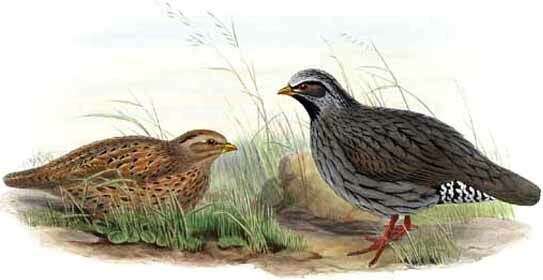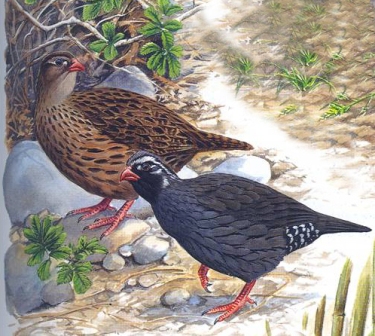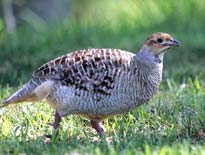Himalayan Quail
The Himalayan Quail (Ophrysia superciliosa) or Mountain Quail is a medium-sized quail belonging to the pheasant family. It was last reported in 1876 and is feared extinct. This species was known from only 2 locations (and 12 specimens) in the western Himalayas in Uttarakhand, north-westIndia. The last verifiable record was in 1876 near the hill station of Mussoorie.
Description
The red bill and legs of this small dark quail and white spots before and after the eye make it distinctive. The male is dark grey with bleak streaks and a white forehead and supercilium. The female is brownish with dark streaks and greyish brow. Like the male it has a white spot in front of the eye and a larger one behind the eye.[3] It is believed to fly only when flushed at close quarters and was found in coveys of five or six. The habitat was steep hillsides covered by long grass. The genus name is derived from Ophryswhich refers the brow.
This quail has long tail coverts and the 10 feathered tail is longer, nearly as long as the wing, than in most quails.[6] The feathers of the forehead and bristly and stiff.
The species was described in 1846 by J. E. Gray from living specimens in the collection of the Earl of Derby at Knowsley Hall, and he gave the locality as "India" with a query.[6] It was not until 1865 that it was first found in the wild by Kenneth Mackinnon who shot a pair in November, in a hollow between Budraj and Benog, behind Mussoorie, at about 6,000 feet (1,800 m) elevation.[6] Two years later, again in November, five specimens were obtained by a group near Jerepani (Jharipani). In December 1876, Major G. Carwithen obtained a specimen from the eastern slopes of Sher-ka-danda, close to Nainital, at an elevation of 7,000 feet (2,100 m). Frank Finn suggested that it was a migratory bird, arriving in winter, although expressing doubts on account of the short wings. The birds near Mussoorie as observed by Hutton and others occurred in small coveys of six to ten, that kept to high grass and scrub, fed on seeds of grass, were difficult to flush, and had a shrill whistling note when flushed. They appeared to arrive about November, but in one case stayed as late as June, after which they disappeared.


Specimens and records
Specimens are known from
- Uttar Pradesh (now Uttarakhand), Mussoorie (1836, 2 specimens, type locality)
- 5 km to the north-west of Mussoorie, between Badraj and Benog, 1,850 m. (November 1865, 1 specimen, 1 lost)
- Jharipani, 5 km to the south of Mussorie, c.1,650 m (November - June 1867/68 or 1896/70, 4 specimens total)
- Eastern slopes of Sher-ka-danda near Nainital, 2,100 m (December 1876, 1 specimen)
By 1904 it was already considered as a rarity. One extant pre-1950 specimen and several lost ones of an unknown date are from undetermined locations.
Sidney Dillon Ripley (1952) records a local bird name sano kalo titra ("small black/dusky partridge") from the Dailekh district of Nepal. The only bird from the general area that seems to fit such a description would be a male Himalayan Quail.
Ecology
All records of the Himalayan Quail are in the altitude range of 1,650 to 2,400 m. They were seen in patches of tall grass ("high jungle grass", "tall seed-grass", see terai) and brushwood on steep hillsides, particularly on the crests of south- or east-facing slopes. It probably bred around September. The June specimen is a yearling male in moult.
A. O. Hume (Stray Feathers 9 [1880 or 1881]: 467-471) suggested that it was similar in habit to the Manipur Bush-quails Perdicula manipurensis in that it was seen very rarely, except at dawn or dusk, keeping to tall grassland, relying on its legs rather than its wings for escape and only flying when closely approached. The fluffy, soft plumage suggests it was adaptated for low temperatures; it has been suggested that the birds migrated north and uphill in the summer months to the higher mountains, but the shape and size of its wings do not suggest a bird capable of flying long distances.
Status
Recent Indian records seem unlikely given that the area is well populated, the habitat extensively altered by human activity, and recent surveys have not located birds. Tourism is a key economic factor of the region, so it seems unlikely that these birds could escape the eyes of observers. However there is no evidence and the habitat available here is no longer suitable due to the population pressure. The early 1990s "sightings" seem to have been based on a misidentification; the habitat type in the area in question is different (conifer forest) anyway.In addition there is a recent set of possible sightings around Nainital in 2003.
Judging from the species' known distribution and habitat requirements, it is possible that it was present in western Nepal too or even still is. However, a series of late 20th-Century scientific expeditions to Uttarakhand, including by respected organizations such as the Bombay Natural History Society (BNHS) have failed to turn up evidence of the species. Yet, the species has not been formally declared "extinct" by IUCN.
| Himalayan Quail | |
|---|---|
 | |
| Painting by John Gould based on specimens #1836a and #1836b | |
| Conservation status | |
| Scientific classification | |
| Kingdom: | Animalia |
| Phylum: | Chordata |
| Class: | Aves |
| Order: | Galliformes |
| Family: | Phasianidae |
| Genus: | Ophrysia Bonaparte, 1856 |
| Species: | O. superciliosa |
| Binomial name | |
| Ophrysia superciliosa (Gray,JE, 1846) | |
 | |
| Synonyms | |


No comments:
Post a Comment